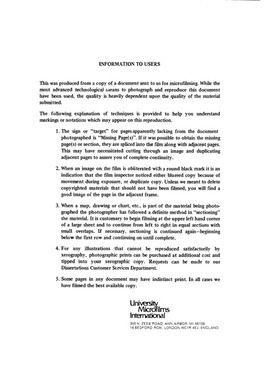| dc.contributor.author | Grayson, Robert Calvin, | en_US |
| dc.date.accessioned | 2013-08-16T12:28:01Z | |
| dc.date.available | 2013-08-16T12:28:01Z | |
| dc.date.issued | 1980 | en_US |
| dc.identifier.uri | https://hdl.handle.net/11244/4719 | |
| dc.description.abstract | The Wapanucka Formation is exposed in a series of arcuate, thrust fault blocks in the frontal Ouachita Mountains, Oklahoma. The formation is fault repeated as many as five times in a distance of approximately two miles (3.2 kms). These fault blocks exposures range from several miles (4.8 kms) to nearly fifty miles (80 kms) in linear extent. Thirty-three measured sections spaced along this narrow outcrop belt provide control for stratigraphic study and subdivision. The formation is subdivided into four members that contain part or all of four conodont zones. | en_US |
| dc.description.abstract | The Wapanucka Formation contains part or all of four conodont zones that are defined on the earliest occurrences of time sensitive platform elements. The oldest zone recognized, the Idiognathoides convexus zone, indicates equivalence to the Kessler Limestone Member of the type Morrowan Series of the Ozark area. The succeeding Neognathodus kanumai-Idiognathoides ouachitensis and Diplognathodus orphanus zones are represented by an erosional gap between the Kessler and overlying Trace Creek Shale, type Morrowan Series. The Streptognathodus elegantulus zone is the youngest biostratigraphic unit present in the Wapanucka. The zone is also present in the Trace Creek Shale, Ozark area. Its occurrence is thought to indicate an early Atokan age. | en_US |
| dc.description.abstract | The four members, where they co-occur, include in ascending order: (1) the Chickachoc Chert Member, (2) the lower limestone member, (3) the middle shale member, and (4) the upper sandstone/limestone member. The lower limestone is a marine shoal water facies. It is a complex lithologic mosaic consisting of varying proportions of oolite and bioclastic calcarenite, micritic and spiculiferous limestone, limestone pebble conglomerate, and shale interbeds. The shoal water lithologies that constitute the lower limestone, based on conodont correlations, are the precise time equivalent to the basinal Chickachoc Chert facies. The Chickachoc Chert Member consists of shale, spiculite, spiculiferous limestone, and rare interbeds of cross-bedded bioclastic calcarenite. The lower limestone and Chickachoc Chert were deposited on a basinward sloping surface. The middle shale is a fine grained clastic wedge that represents a basin fill stage of sedimentation. To a considerable extent, this clastic influx diminished the basinward sloping bathymetric profile that had existed. Subsequently, deposition of carbonate and quartz sand now assigned to the upper member began on a more nearly horizontal substrate. Bioclastic clacarenite and quartz sand accumulated as a system of offshore bars. Interbar facies include micritic and spiculiferous limestone, and shale. | en_US |
| dc.format.extent | xvi, 319 leaves : | en_US |
| dc.subject | Geology. | en_US |
| dc.title | The stratigraphy of the Wapanucka Formation (Lower Pennsylvanian) along the frontal margin of the Ouachita Mountains, Oklahoma. | en_US |
| dc.type | Thesis | en_US |
| dc.thesis.degree | Ph.D. | en_US |
| dc.thesis.degreeDiscipline | Conoco Phillips School of Geology and Geophysics | en_US |
| dc.note | Source: Dissertation Abstracts International, Volume: 41-03, Section: B, page: 0862. | en_US |
| ou.identifier | (UMI)AAI8018922 | en_US |
| ou.group | Mewbourne College of Earth and Energy::Conoco Phillips School of Geology and Geophysics | |
